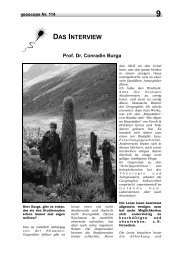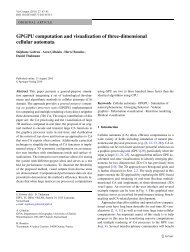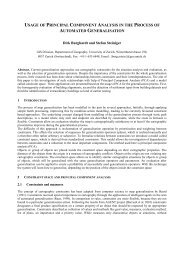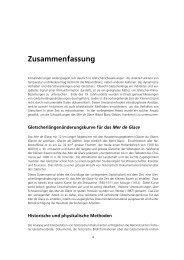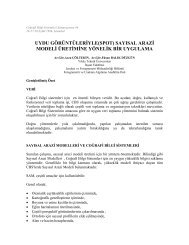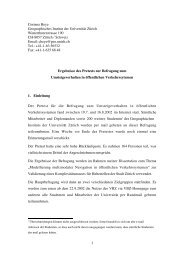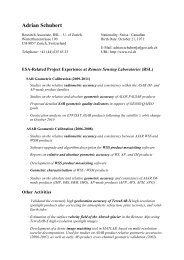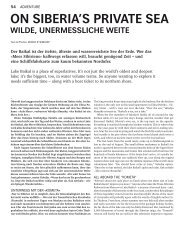Pedogenesis of Chernozems in Central Europe — A review
Pedogenesis of Chernozems in Central Europe — A review
Pedogenesis of Chernozems in Central Europe — A review
Create successful ePaper yourself
Turn your PDF publications into a flip-book with our unique Google optimized e-Paper software.
294 E. Eckmeier et al. / Geoderma 139 (2007) 288–299<br />
Scheffer and Meyer (1963) warned to draw conclusions from<br />
the existence <strong>of</strong> <strong>Chernozems</strong> to former climate and vegetation<br />
and suggested that they could have formed under forests.<br />
Scheffer et al. (1959/60) and Rohdenburg and Meyer (1968)<br />
gave evidence for a development <strong>of</strong> black soils under forests<br />
when low precipitation or stagnic conditions stop decalcification.<br />
Ehwald et al. (1999) summarized the recent discussion<br />
about the formation <strong>of</strong> <strong>Chernozems</strong> <strong>in</strong> the <strong>Central</strong> German dry<br />
area. Here, pollen data suggested that the replacement <strong>of</strong> the<br />
steppe vegetation by birch and p<strong>in</strong>e started <strong>in</strong> Preboreal and was<br />
completed <strong>in</strong> Atlantic with the appearance <strong>of</strong> deciduous forests.<br />
However, the <strong>in</strong>vestigation <strong>of</strong> fossil mollusc fauna lead Mania<br />
and Preuss (1975) to conclude that steppe vegetation was still<br />
present <strong>in</strong> Atlantic. But the mollusc fauna gives evidence only<br />
for the local vegetation history, whereas palynological data<br />
represents a larger region. Moreover, the molluscs orig<strong>in</strong>ated<br />
from colluvial sediments, and a lack <strong>of</strong> vegetation to cover soil<br />
is a precondition for erosion and subsequent colluviation. The<br />
expansion <strong>of</strong> deciduous forests dur<strong>in</strong>g Atlantic would be the<br />
more conv<strong>in</strong>c<strong>in</strong>g scenario (Ehwald et al., 1999).<br />
Ehwald et al. (1999) tried to elucidate the problem <strong>of</strong><br />
<strong>Chernozems</strong> formed under forest by compar<strong>in</strong>g <strong>Central</strong> German<br />
soils with Eastern <strong>Europe</strong>an and Western Siberian soils. In<br />
Russia, Typical and Leached <strong>Chernozems</strong> occur under farmland<br />
and open deciduous forests. These soils should correspond to the<br />
German <strong>Chernozems</strong> under farmland. The Russian Grey Forest<br />
Soils, covered by dense forests, relate to the <strong>Central</strong> <strong>Europe</strong>an<br />
Phaeozems and Luvisols. The exam<strong>in</strong>ation <strong>of</strong> humic horizons <strong>of</strong><br />
<strong>Chernozems</strong> <strong>in</strong> the steppe region near Kursk seemed to prove the<br />
unchanged conservation <strong>of</strong> <strong>Chernozems</strong> under open deciduous<br />
forests dur<strong>in</strong>g some thousands <strong>of</strong> years. This could be an<br />
evidence for their genesis under an open forest or a forest–steppe<br />
(Ehwald et al., 1999). More examples for <strong>Chernozems</strong> under<br />
open forests were described <strong>in</strong> Austria (Franz, 1955).<br />
A strong argument for a development <strong>of</strong> <strong>Chernozems</strong> under<br />
steppe vegetation was the existence <strong>of</strong> burrows (krotov<strong>in</strong>as) built<br />
by hamsters (Cricetus) orgroundsquirrels(Citellus), which live<br />
<strong>in</strong> open landscapes. Their soil-mix<strong>in</strong>g activity was supposed to<br />
be essential for the formation <strong>of</strong> the mollic A horizon. In the<br />
<strong>Central</strong> German dry area only the existence <strong>of</strong> hamsters could be<br />
proved until now, but they probably <strong>in</strong>habited the region after<br />
agriculture was established (Lange, 1965; Ehwald et al., 1999).<br />
More arguments aga<strong>in</strong>st bioturbation as major soil form<strong>in</strong>g<br />
process would be the existence <strong>of</strong> lam<strong>in</strong>ated <strong>Chernozems</strong> <strong>in</strong><br />
Lower Saxony (Gehrt et al., 1999) and the results <strong>of</strong> radiocarbon<br />
dat<strong>in</strong>g, which showed an <strong>in</strong>crease <strong>of</strong> age <strong>of</strong> soil organic matter<br />
with <strong>in</strong>creas<strong>in</strong>g soil depth (Scharpenseel et al., 1986).<br />
6. Climate and relief <strong>—</strong> Conservation and degradation <strong>of</strong><br />
<strong>Chernozems</strong><br />
Based on the assumption that <strong>Chernozems</strong> are steppe soils, a<br />
model was developed concern<strong>in</strong>g conservation and degradation<br />
affected by climatic changes (e.g. Rau, 1968 for <strong>Central</strong><br />
Germany). <strong>Chernozems</strong> formed under steppe conditions were<br />
expected to stay preserved <strong>in</strong> regions with a balanced or negative<br />
water balance. In <strong>Central</strong> <strong>Europe</strong>, this would be <strong>in</strong> geographical<br />
regions with a mean annual precipitation <strong>of</strong> less than 500 mm, as<br />
stated by Meyer (1926). With <strong>in</strong>creas<strong>in</strong>g precipitation and<br />
leach<strong>in</strong>g, the translocation <strong>of</strong> clay covered with humic material<br />
started and <strong>Chernozems</strong> were transformed <strong>in</strong>to Phaeozems,<br />
Luvisols or Albeluvisols (Rau, 1968; Driessen et al., 2001). This<br />
degradation process was also described for Russian soils, where<br />
Alexandrovskiy and Chichagova (1998) <strong>in</strong>vestigated Luvisols<br />
with a fossil humus horizon and expla<strong>in</strong>ed its formation with a<br />
climate change. After a Chernozem developed <strong>in</strong> Early and<br />
Middle Holocene, an <strong>in</strong>crease <strong>in</strong> precipitation led to humus<br />
degradation <strong>in</strong> Late Holocene. Dur<strong>in</strong>g 2000 to 3500 years the<br />
Chernozem was transformed to a Luvisol, which still conta<strong>in</strong>s<br />
Chernozem material as a second A horizon.<br />
The climo-genetic model was adopted to generate a<br />
chronology <strong>of</strong> Chernozem formation and degradation relat<strong>in</strong>g<br />
to climate change and archaeological phases. Accord<strong>in</strong>g to that<br />
chronology, the formation would have been completed before the<br />
Early Neolithic Period (5500–5000 BC), and leach<strong>in</strong>g and<br />
degradation would have started with the onset <strong>of</strong> warmer and<br />
more humid Atlantic climate before the Bronze Age (before 2200<br />
BC). Therefore, the <strong>Central</strong> <strong>Europe</strong>an <strong>Chernozems</strong> should have<br />
stayed preserved <strong>in</strong> areas with negative water balance, whereas<br />
<strong>in</strong> other areas they transformed <strong>in</strong>to Luvic Phaeozems or even<br />
Haplic Luvisols which do not show traces <strong>of</strong> their chernozemic<br />
past anymore (Scheffer and Meyer, 1963; Schalich, 1981).<br />
Some authors referred to the factors relief and hydrological<br />
conditions: <strong>Chernozems</strong> were assumed to be better preserved<br />
under soil water supply that could stop the process <strong>of</strong><br />
decalcification (Roeschmann, 1968; Thater and Stahr, 1991).<br />
On the other hand, black soils affected by high water levels<br />
(Gleyic or Stagnic <strong>Chernozems</strong>; FAO-WRB) could not only be<br />
preserved but may even have been formed under wet conditions<br />
(Scheffer and Meyer, 1958). Black Chernozem material could<br />
also be protected under colluvial sediments, especially when<br />
calcareous material stopped the leach<strong>in</strong>g process (Sabel, 1982).<br />
However, the factors affect<strong>in</strong>g the spatial distribution <strong>of</strong><br />
<strong>Chernozems</strong> are not well-known yet. Although most authors<br />
stressed a change <strong>of</strong> climate, this factor alone could not expla<strong>in</strong><br />
the present distribution <strong>of</strong> <strong>Chernozems</strong>. Stremme (1936) and<br />
Bailly (1972) could not correlate precipitation and the distribution<br />
<strong>of</strong> <strong>Chernozems</strong>, and Sabel (1982) stressed the importance<br />
<strong>of</strong> relief position for Chernozem preservation. Altermann<br />
and Fiedler (1975) found that the primary carbon content <strong>of</strong> the<br />
loess parent material is <strong>of</strong> greater importance to the pedogenesis<br />
<strong>of</strong> <strong>Chernozems</strong> than microclimate.<br />
In fact, <strong>Chernozems</strong> <strong>of</strong>ten appear <strong>in</strong> patches but not <strong>in</strong><br />
extensive covers, with no obvious relation to soil form<strong>in</strong>g factors<br />
as climate or relief. Examples were given by Bailly (1972) and<br />
Gehrt et al. (1995, 2002) for Lower Saxony, where grey<br />
(‘Grauerde’) and black soils (‘Schwarzerde’) are distributed <strong>in</strong><br />
sharply def<strong>in</strong>ed neighbour<strong>in</strong>g patches without any differences <strong>in</strong><br />
parent material, relief position or soil properties (description<br />
<strong>in</strong> Fig. 1). Bailly (1972) <strong>in</strong>vestigated <strong>Chernozems</strong> <strong>in</strong> Northern<br />
Germany and found no direct correlation between their distribution<br />
and climate, relief, parent material, hydrology or distribution<br />
<strong>of</strong> forest and farmland. He suggested that still unknown<br />
factors <strong>in</strong>fluenced the preservation <strong>of</strong> <strong>Chernozems</strong>. Kleber et al.






